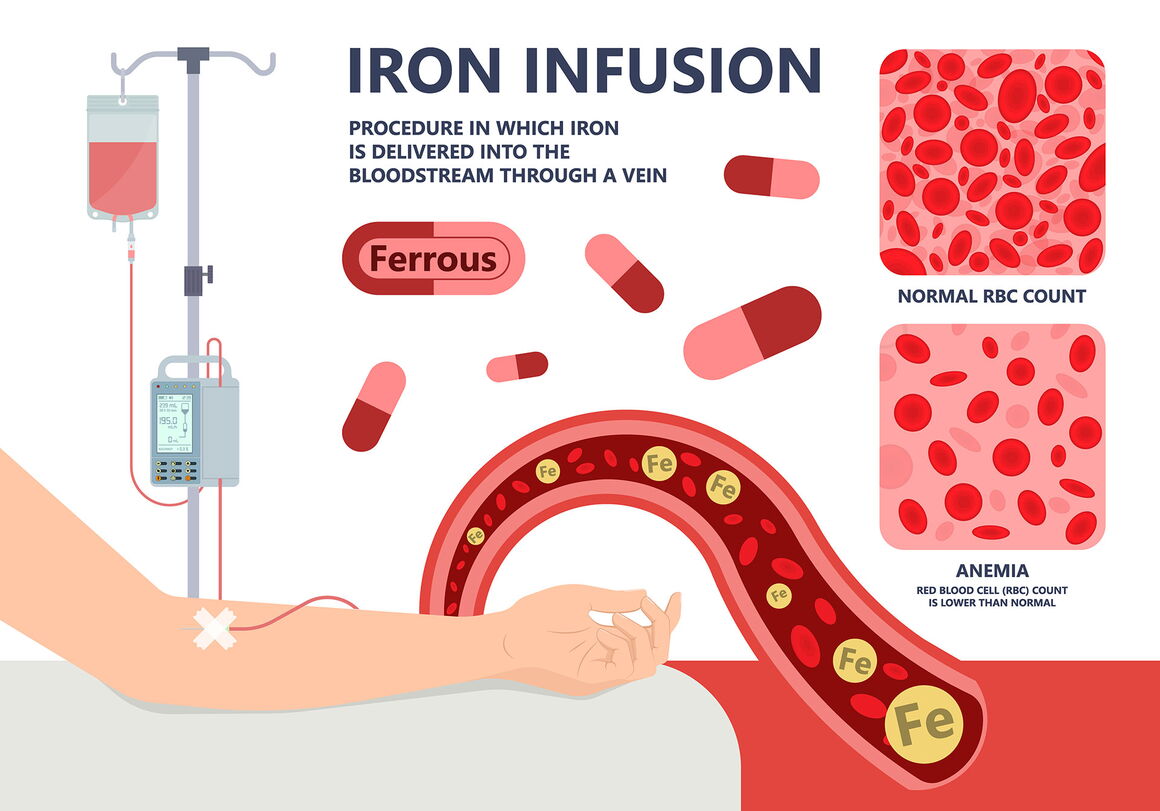Frequently asked questions (FAQ) about iron deficiency
Iron deficiency: what does therapy look like?
With very low ferritin levels (e.g. below 20), better nutrition and/or oral iron medication will hardly ever be successful in the short term. Only infusions can significantly shorten the period of suffering.
Last update on 03.04.2025 by Dr. Peter Meyer.
Definition of iron deficiency
It is not the iron value but the ferritin value that is decisive. The ferritin standard value varies from 10 - 350 nanograms/milliliter of blood. With this wide range, it is necessary to find out the patient's individual ferritin level. Experience shows that the symptoms of iron deficiency in most women only disappear in the higher normal range. It is therefore not expedient to focus solely on the lower standard ferritin value.
Last update on 03.04.2025 by Dr. Peter Meyer.
Causes: How does iron deficiency anemia develop?
If the signs of an incipient iron deficiency are ignored or misjudged, the patient can also slip into anemia if ferritin levels are very low, with additional symptoms such as shortness of breath and palpitations. Severe bleeding due to injury or childbirth can also lead directly to anemia.
Last update on 03.04.2025 by Dr. Peter Meyer.
Why don't iron-rich foods or tablets help me with my iron deficiency?
Many patients wonder why their iron levels do not rise despite eating an iron-rich diet or taking tablets. The reason often lies not in the iron intake, but in iron absorption - i.e. the body's ability to absorb iron in the intestine in the first place.
In fact, only around 10% of the iron supplied (whether from red meat or iron tablets, for example) is absorbed via the digestive tract. The right environment in the gastrointestinal tract is crucial:
- Absorption is most successful in an acidic environment.
- If you take milk, alkalizing agents or so-called stomach protectors (acid blockers), absorption is significantly reduced.
- On the other hand, acidic drinks containing vitamin C, such as apple or lemon juice (unsweetened), are recommended as they can promote absorption.
However, despite optimizing the diet, the effect fails to materialize in many patients. In such cases, an intravenous iron infusion is often the most effective solution - fast-acting and independent of the intestine. Many patients report a noticeable “WOW effect” shortly after the first infusion - more energy, better concentration and an increased general sense of well-being.
Last update on 03.04.2025 by Dr. Peter Meyer.
Why is the ferritin value so important in the diagnosis of iron deficiency?
The serum level of ferritin is the most specific marker in the diagnosis of iron deficiency and correlates best with the clinical symptoms. Not the free iron! Ferritin is a protein that stores iron - a low ferritin level therefore usually indicates that the body's iron stores are depleted.
However, there are exceptions: In cases of acute or chronic inflammation - such as flu, colitis or other inflammatory diseases - ferritin levels can be artificially elevated. This is because in such situations the liver produces additional ferritin, regardless of the actual iron stores.
We therefore always assess the ferritin value in the overall context of your symptoms, laboratory values and medical history. In this way, we ensure that the diagnosis is reliable and individually substantiated.
Last update on 03.04.2025 by Dr. Peter Meyer.
